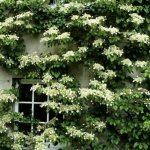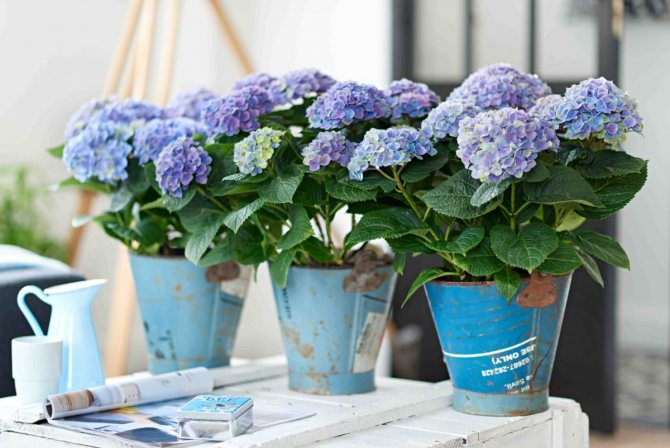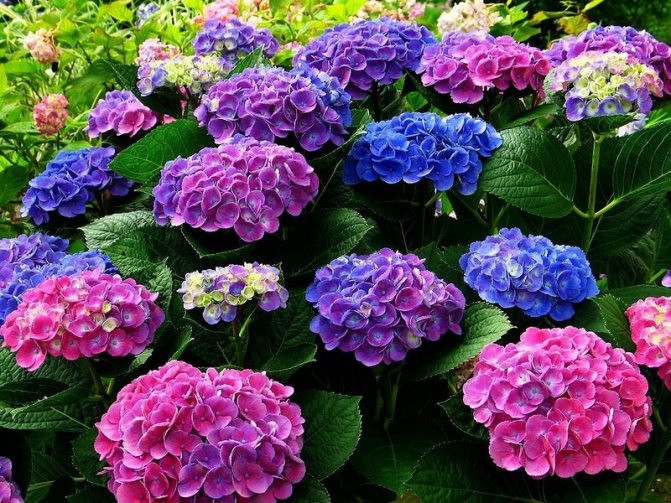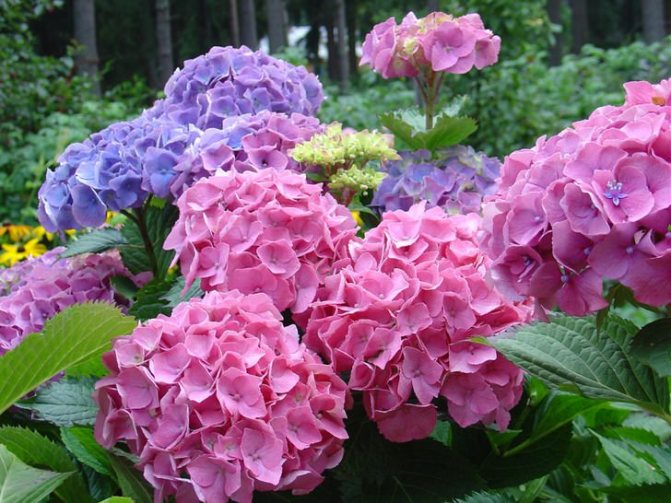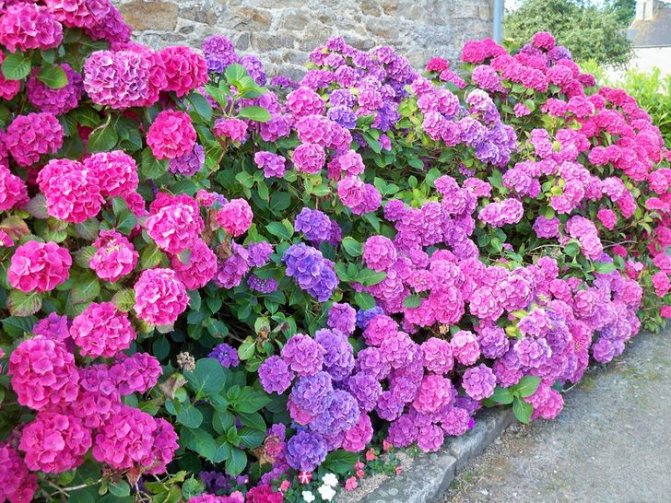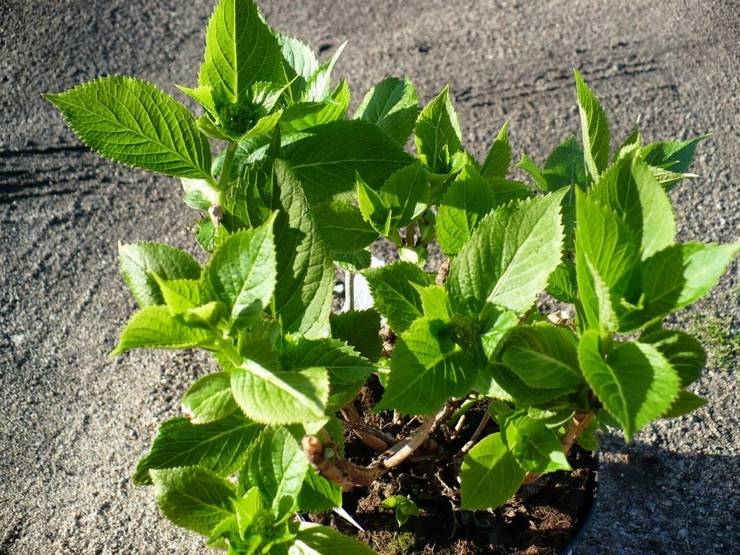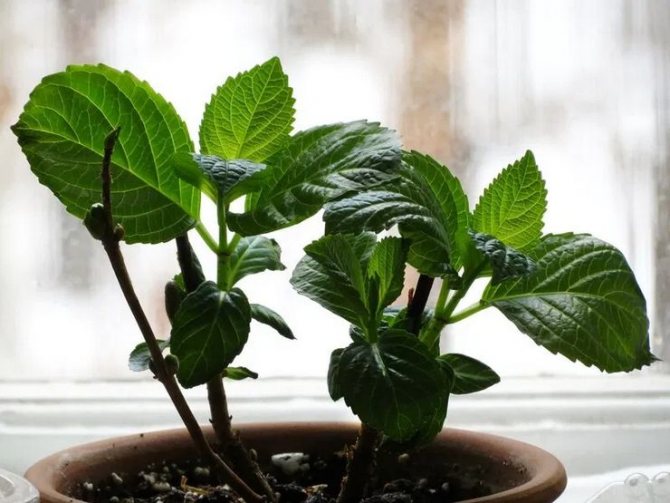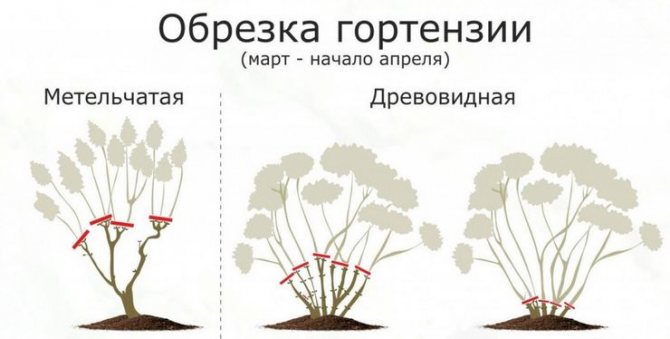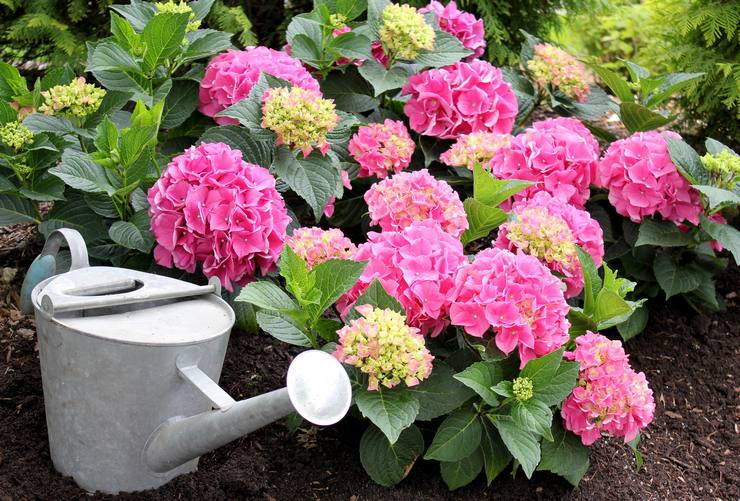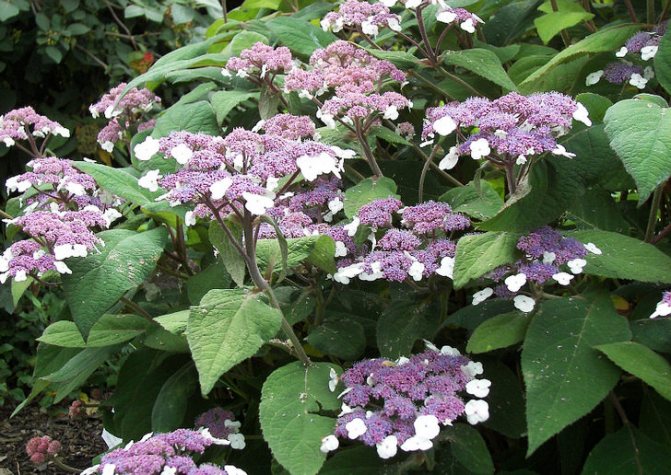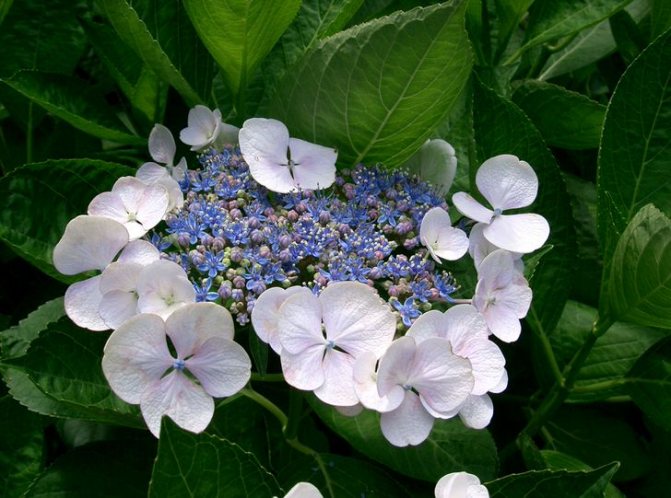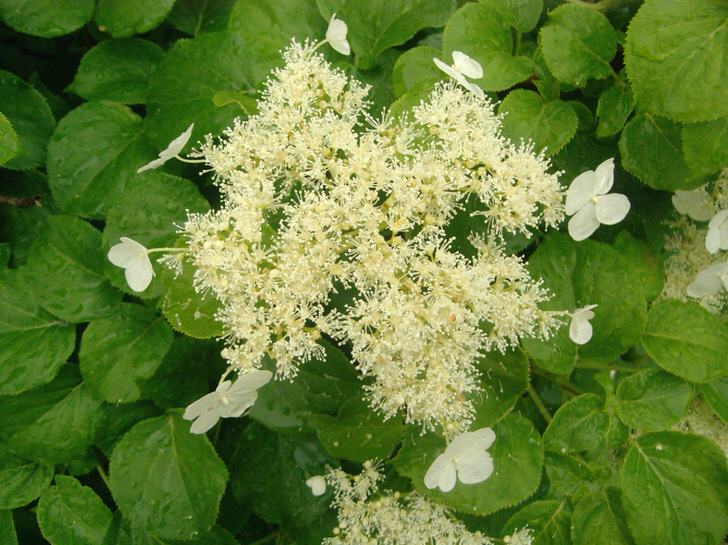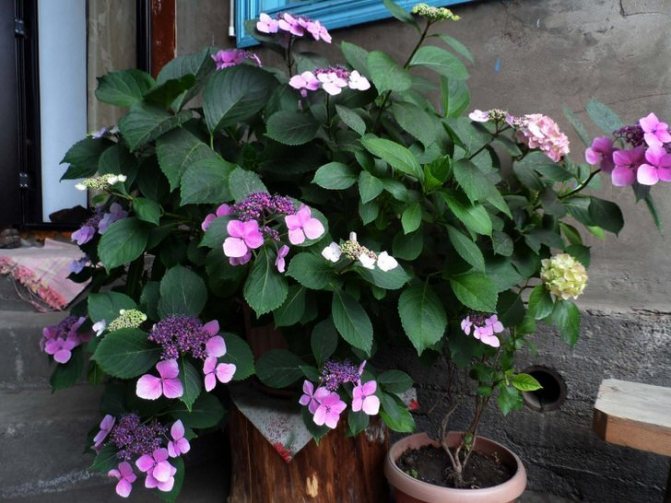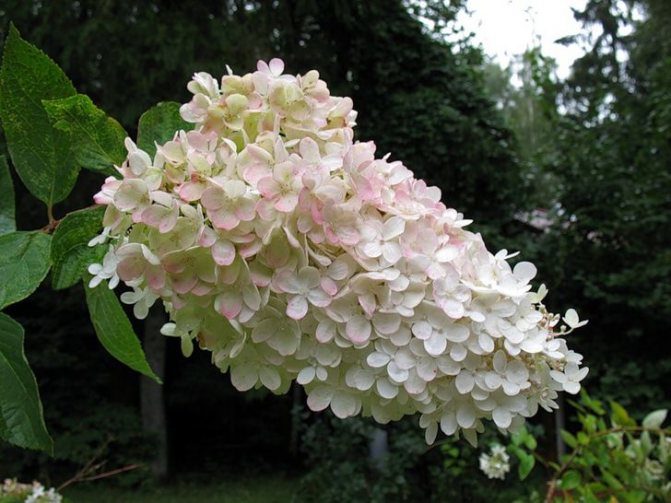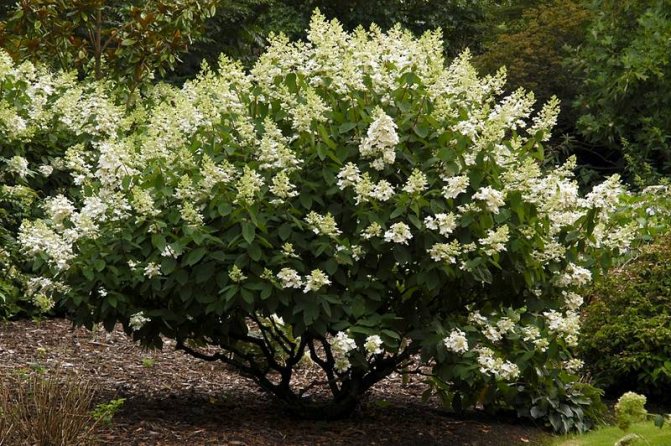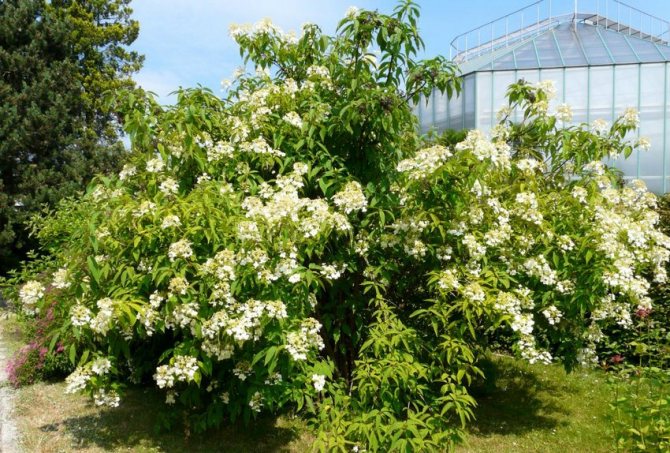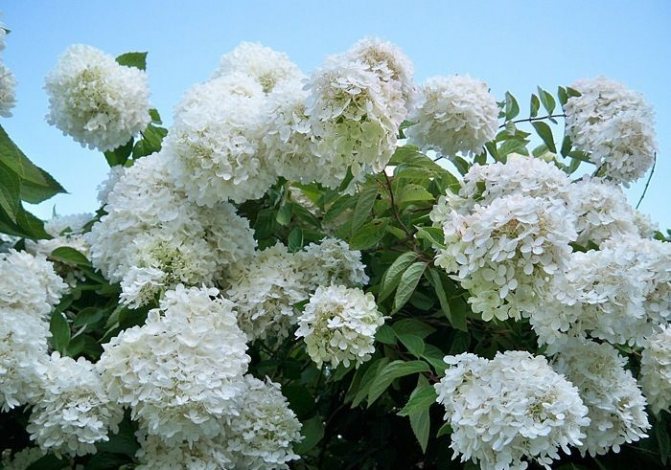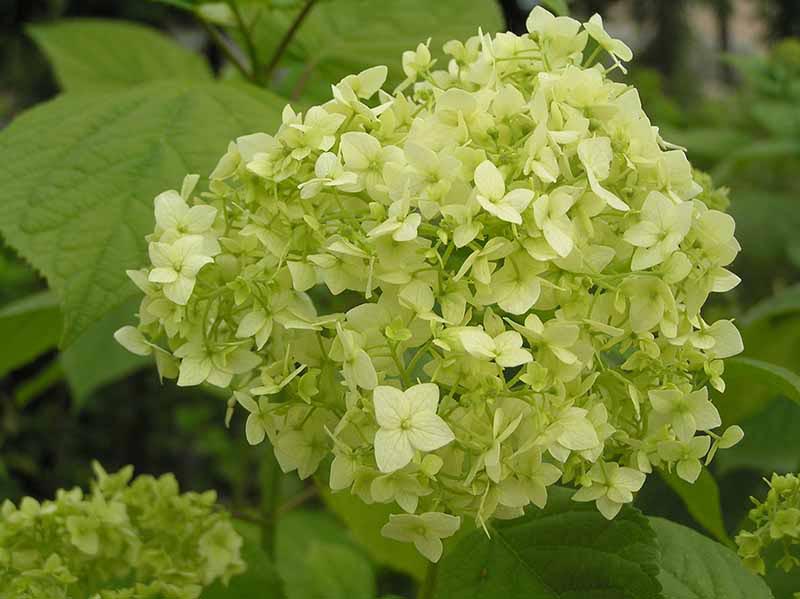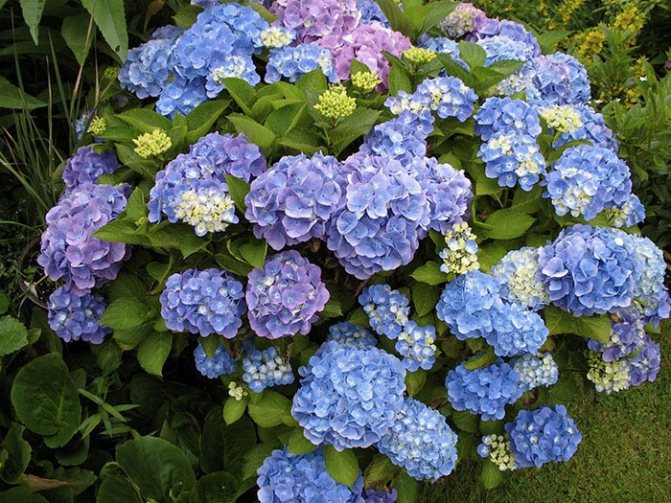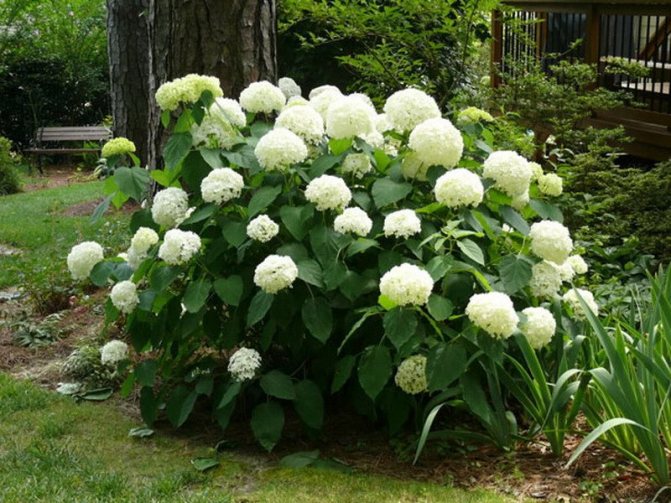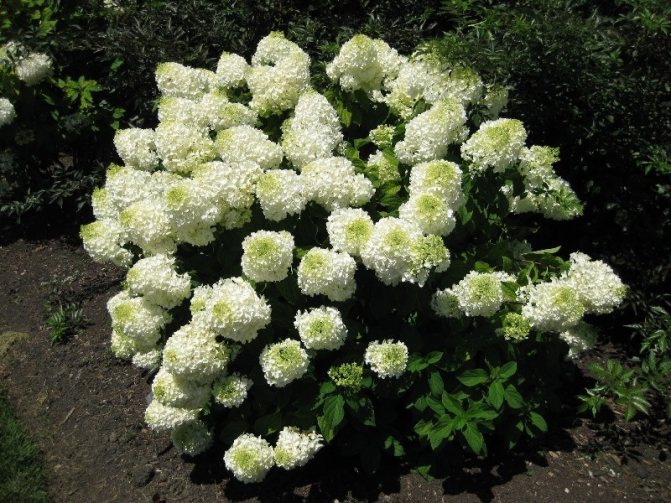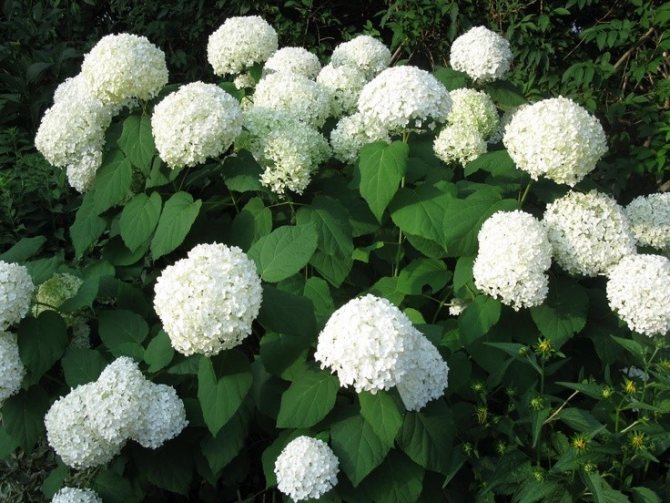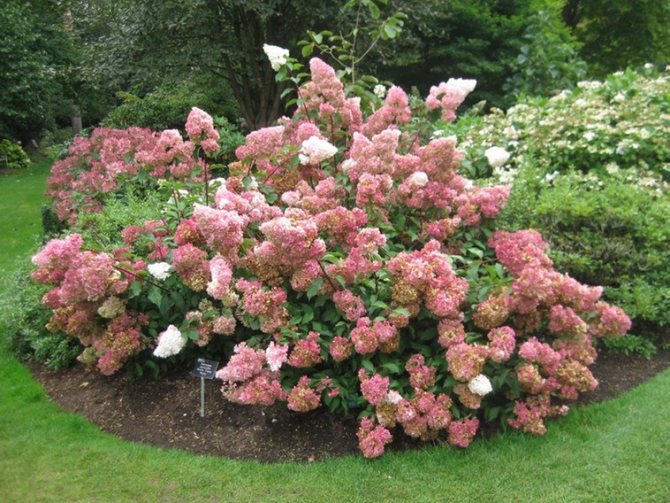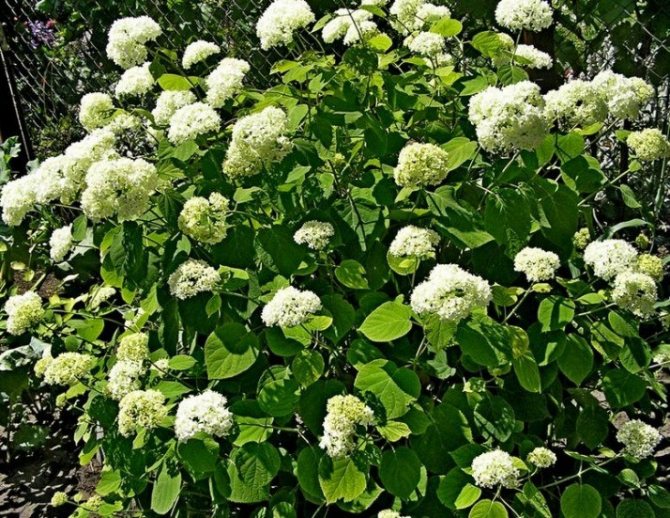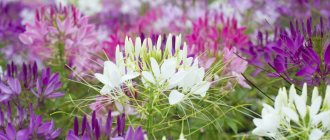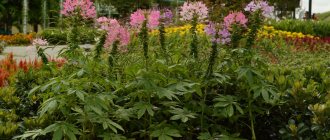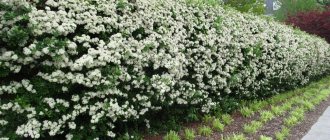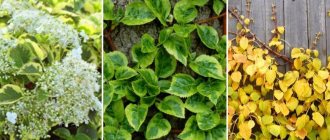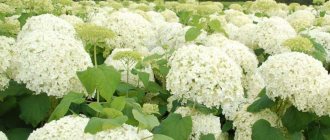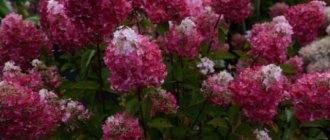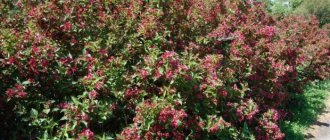Hydrangea - a stunning in its beauty ornamental shrub, striking with the magnificence of huge multi-colored caps-inflorescences that adorn the blooming garden from early summer to late autumn.
This is a rather thermophilic plant., but now many new, very interesting varieties have been created that perfectly tolerate winter frosts, and some of them do not even require additional shelter.
Hydrangea today Is one of the most popular beautifully flowering crops. Many gardeners want to grow it on their plots and ask to tell what species and varieties are suitable for planting in regions with cold winters. Therefore, today let's talk specifically about frost-resistant hydrangeas.
Hydrangea paniculata
Panicle hydrangea is one of the most suitable decorative species for Russian gardens. It grows on average up to 3 meters, in especially good conditions - up to 5 meters. The pubescent elliptical leaves reach a length of 12 cm. The flowers are collected in a paniculate pyramidal inflorescence.
Flowering begins in June and lasts until October, but peaks in August and September.
Only the blossoming buds have a greenish color, over time they acquire a white or cream shade, and in autumn they become pink or slightly purple.
The inflorescences emit a delicate pleasant aroma, which makes them good honey plants.
Panicle hydrangea prefers to grow in partial shade or shade, because in the sun its inflorescences become smaller. It should be protected from wind and drafts. The species is quite frost-resistant, some varieties can tolerate up to -25 degrees.
In view of this, they can be grown in both central and northern parts of Russia. With sufficient snow cover, the plant does not need shelter in winter; without snow, light shelter is needed.
In areas without severe frosts, planting a bush can be done both in spring and in autumn, in the northern regions it is better in spring. Since panicle hydrangea grows rapidly, it needs annual spring pruning. It will not negatively affect future flowering, since the buds of this species appear on the shoots of the current year.
Among the wide variety of types of panicle hydrangea, the most popular are:
- Grandiflora - has dense inflorescences about 30 cm long. The flowers are sterile, at first white, by autumn they acquire a pinkish color. The bush is about 2 meters high.
- Kyushu is frost resistant. The height of the bush is 1.5-2 meters. White inflorescences acquire a pink color by autumn.
- Brussels Lace - large inflorescences are ivory.
- Pinky Winky is a bush with a height of 1.5-2 meters. It has conical inflorescences that acquire a pink-purple color. Sterile flowers predominate. The flowering period is from August to October.
- Limelight - bush height up to 2 meters. It has dense inflorescences of sterile greenish flowers that turn pink by autumn.
- Dart's Little Dot is a low-growing variety up to 1 meter high. Has corymbose pink inflorescences.
- Phantom is a bush up to 3 meters high. It has very large pyramidal inflorescences of a creamy white color, turning pink by autumn.
- Vanille Fraise - the height of the bush is about 2 meters. Large conical inflorescences first have a white color, then turn pink, and by autumn they become almost red.
Planting seedlings in open ground
Planting of seedlings on the site is carried out in the spring, 2 years after sowing the seeds. In regions with a temperate climate, planting can be postponed until autumn.
Seat selection
All hydrangea varieties love light. But tree-like, rough and ground cover - they prefer light partial shade. This must be taken into account when choosing a site for planting. The soil is preferably neutral or slightly acidic, loose and nutritious.
On a note! It is better that shrubs with superficial roots do not grow near the hydrangea. This will create a problem in the future - the plants will pull moisture and nutrients from the top layer of the soil and they will not be enough.
Landing rules
Dig a hole for each seedling 2 times the size of the root system. Pour peat, complex fertilizers mixed with soil into them. Do not add lime, it is fatal to the flower.
Remove the seedlings from the pots along with the soil, gently shake it off. Place them in the holes, spread the roots. Sprinkle with soil mixed with compost. The root collar should protrude slightly from the surface of the ground. Water the area and mulch with bark or needles.
Hydrangea grows strongly over time. This must be taken into account if several shrubs are planted nearby. The distance between them must be kept at least 1.5 m.
Hydrangea
Treelike hydrangea is a bush with a height of 1 to 2.5 meters. The oblong, serrated leaves have long petioles. Above, the leaf plate is green, below it is light, bluish.
The inflorescences are flat or spherical and reach 15-20 cm in diameter. The buds appear on the shoots of the current year. The lush and airy inflorescences are dominated by fruiting flowers.
Treelike hydrangea is suitable for growing by novice growers, since it is unpretentious, shade-tolerant and frost-resistant. Growth of about 30 cm per year ensures rapid growth. After 3 years, a small seedling turns into a beautiful bush. Blooms for a long time: from early summer to September.
This species is unpretentious to the soil, however, it likes abundant and regular watering, and does not tolerate drought. Prefers shade or partial shade.
It does not require special preparation for winter, since it can winter well without shelter. But still it is better to cover young specimens.
Pruning branches in early spring promotes rapid recovery of the bush after winter.
Treelike hydrangea does not have a rich varietal variety. The most popular varieties for Russian gardens are:
- Incrediball - bush height up to 1.5 meters. Affects large spherical white inflorescences.
- Annabelle is a powerful shrub 1-1.5 meters high. Green leaves reach 10-15 cm in length. White globular inflorescences can reach 25 cm in diameter. The species is highly frost-resistant.
- Invincibelle Spirit is a new breeding variety. Freshly blossomed inflorescences have a dark pink color, which brightens a little by autumn.
- Sterilis is a bush with a height of 1.5-2 meters, crown diameter - up to 2.5 meters. Large hemispherical inflorescences at first have a greenish tint, eventually become snow-white. The flowering period is from July to late autumn.
- Hayes Starburst - bush height up to 1.5 meters. Resistant to pests and diseases. It has spherical white inflorescences up to 25 cm in diameter. Flowers are double.
Growing seedlings from seeds
The seed method is only suitable for species of hydrangeas. It is also used by specialists for breeding new varieties. Seeds are not planted directly into open ground. They are germinated in a pot for 2 years before sending the seedlings to the site.
Soil and capacity
You can sow seeds for seedlings in the fall. Fill the container with a substrate, which consists of leafy soil (4), peat (2), sand (1).Spread the seeds over the surface, cover with a thin layer of soil, spray with a spray bottle. Cover crops with foil. Germinate seeds at a temperature of + 14 ... 20 ° C. The film must be removed from time to time for airing. Maintain the substrate in a slightly moist state.
Seedling care
The seeds will germinate in 1-1.5 months. The cover can then be removed. The dive of seedlings is carried out 2 times. First, they are seated after the appearance of the first leaves. The second time - in May, planting each seedling in a separate pot with a diameter of 7 cm.
To harden young plants after the second pick, they are taken out into the street during the day. It is necessary to grow seedlings within 2 years. In the summer, take it outside as often as possible, and in the winter keep it in a bright, cool place. If buds appear during this period, they are cut off. They greatly weaken young, immature plants.
Stalked hydrangea
Stalked hydrangea is a vine that can reach a length of 25 meters. The leaves are dark green, heart-shaped. Sterile and fruiting flowers are collected in scute inflorescences with a diameter of 10-20 cm. Their color varies from white-green to lilac.
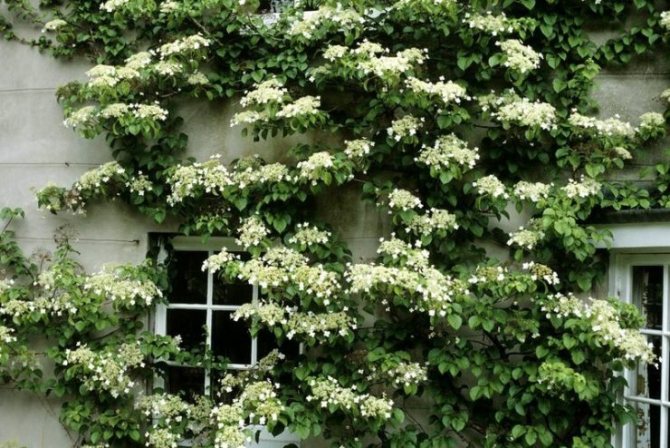
With the help of aerial roots and suckers, the plant weaves up the support. Can be used to decorate walls, arches, arbors, tree trunks. However, in view of the fact that the species does not tolerate severe frosts, it is recommended to remove the vine from the supports and cover it for the winter.
Also, petioled hydrangea is used as a ground cover plant that forms a dense green carpet. In this case, the plant will not bloom.
Prefers partial shade. Recommended for growing in the southern regions of Russia, it can grow in the middle lane.
The most popular varieties of petiolate hydrangea are:
- Cordifolia is a low-growing frost-resistant variety up to 1.5 meters high. The pyramidal-paniculate inflorescence consists of creamy fruiting flowers and sterile white at the edges. Exudes a pleasant honey aroma.
- Miranda - up to 6 meters high. A feature of the variety is the wide serrated leaves with a cream or yellow border.
- Petiolaris is the highest variety, up to 25 meters high. It can creep along the ground or braid supports.
Planting seedlings
Summer seedlings are planted in open ground in spring. If you want the bush to bloom as soon as possible, you should immediately choose a five-year-old plant. If favorable conditions are created, it will bloom in the summer of the year of planting.
- The distance between the bushes must be at least 1 m.
- For the plant, you need to dig a hole twice the size of the seedling's earthen clod.
- The seedling is taken out of the pot with a lump, gently shaken off the ground and dipped in a bucket of water. The moist roots curled around the seedling are gently straightened and directed downward.
- The plant needs to be pruned a little. At the same time, the roots and annual shoots are shortened.
- Together with the soil, organic and mineral fertilizers must be added to the planting pit. They will help the shrub develop strong flower buds by next year.
- Near the roots of the planted plant, you need to remove the old soil to the young roots as much as possible, replacing it with a prepared mixture.
- The planted plant should be generously watered and sprinkled with leaves around the roots.


Hydrangea oakleaf
Hydrangea oakleaf is a two-meter shrub with red shoots. The green leaves are shaped like those of an oak tree. By autumn, the foliage acquires a crimson color, so even a non-flowering bush has a beautiful decorative appearance. White fragrant flowers are collected in spike-shaped inflorescences. It blooms from early summer to September.
The landing site should be chosen in the shade or partial shade, protected from drafts and wind. This species prefers fertile soil, without lime.
Watering is moderate.Oak-leaved hydrangea is not very resistant to frost, therefore, requires winter shelter. Bush pruning is carried out in spring or autumn.
Suitable for the southern regions of Russia.
Growing conditions for indoor hydrangeas
The key to keeping hydrangeas alive and blooming for a long time is the right lighting and temperatures. They do not adapt well to a new place and prefer a stable environment.
Lighting and placement
Even in rooms, hydrangea can grow not only in a brightly lit place, but also in partial shade. Of course, hydrangeas cannot stand strong shading, but diffused light is quite comfortable for them.
Most hydrangeas that do not form into dwarfs do not fit well on windowsills over time. It is quite possible to place them both on furniture and outdoor not far from the window. Bushes cannot stand direct sunlight, they very quickly lead to a loss of decorativeness of inflorescences and foliage.
During flowering, it is better to make sure that the lighting remains soft and unchanged, and the hydrangeas do not change their orientation in relation to the window: turning, moving can be perceived by the plant as stress and cause accelerated fading.
Lighting during the dormant period for hydrangeas is important, but not in the sense that it is for ordinary indoor plants: hydrangeas should be placed in a dark place or put on caps on bushes, protecting them from light. True, only after dropping the leaves. "Naked" hydrangeas are returned to light only after the beginning of the swelling of the buds.
Indoor hydrangeas are plants that overwhelm their neighbors. They are so massive and attractive that few houseplants are capable of not losing their charm next to them.
But a negative influence is not uncommon: hydrangeas next to crops with glossy leathery leaves, impeccable shapes can seem more sloppy and lose some of their aristocratic charm. Therefore, it is better to expose them as living bouquets of soloists, beautiful single decorations. Except, of course, for the company of other hydrangas.
Temperature regime and ventilation
Moving to closed living quarters, hydrangeas become less resistant to temperatures. They need mild conditions and stable cool temperatures, reminiscent of a cozy garden partial shade under the trees.
Hydrangeas look, develop and bloom best of all, which from March to October stay in moderate room temperatures no higher than 20 degrees. A range of 18 to 20 degrees is fine for them. The higher the temperature, the faster the hydrangeas will bloom and the less they will reveal the beauty of their leaves.
The dormant period for hydrangeas should be cool. The maximum allowable temperature for wintering a plant is plus 10 degrees. Optimal - about 5 degrees Celsius. Only after wintering in the coolness can hydrangeas bloom, and the quality of their flowering directly depends on comfortable and stable temperatures.
You can find a suitable place for indoor hydrangeas during wintering both in cellars, basements, cold greenhouses, and between frames or in a cold foyer.
Hydrangeas, as true garden plants, will not refuse to move under the open sky for the summer. It is not necessary to put them on balconies or in the garden, but it is highly desirable.
If you decide to leave the beauties in the room to admire their inflorescences, then they should not suffer from a lack of fresh air. Airing should be neat, and with constantly slightly open doors, it is worth taking measures to protect the bushes from drafts.
If hydrangeas are planned to be transferred to the soil or there is a large collection, they can also winter in the soil - dug in, under an air-dry shelter or together with garden tubs.


Hydrangea large-leaved 'Blushing Bride'.
Hydrangea radiant
Radiant hydrangea is an erect shrub with pubescent shoots up to 2.5 meters high. The dark green toothed leaves are semi-heart-shaped.
The scaly inflorescence has fruiting creamy flowers in the middle and sterile white at the edges. The flowering period lasts a month, starting in July. The fruits ripen in September.
This species is photophilous, prefers high humidity and fertile soil..
Its frost resistance is low, therefore, for the winter, it is necessary to shelter from spruce branches or dry foliage.
But if the bush freezes, in the spring it quickly recovers and blooms. Suitable for cultivation in the southern regions of Russia. Used in group plantings on lawns or for curb plantings along paths.
Reproduction
Like other shrubs, garden hydrangea can reproduce both generatively and vegetatively. Varietal plants are best cultivated by cuttings, dividing the bush or layering. They preserve all the characteristics of the mother plant.
Cuttings
For planting, you can use the shoots that remained after pruning. Each stalk must have 2 internodes. Make the slices oblique, they should be at a distance of 2-3 cm from the node. Plant the cuttings in a peat-sand mixture, deepening by 3 cm. Cover the planting with foil and put in a warm place. Open the greenhouse periodically for ventilation. Keep the substrate moist. After rooting, plant the plant on the site.
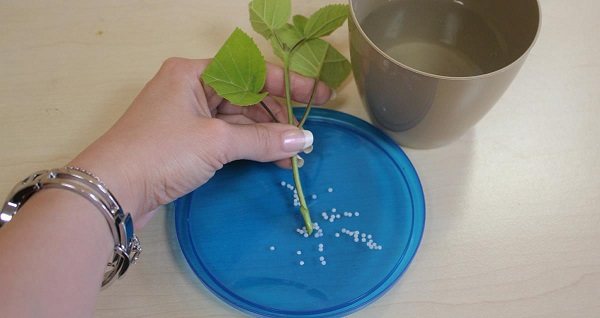

By dividing the bush
The method is suitable for mature plants that need to be rejuvenated. Dig a bush out of the ground, divide it into pieces. It is important that each of them has young shoots with 2-3 buds. Prepare holes of a suitable size for each section. Pour peat into them, a little complex fertilizer. Plant a plant, water it, and mulch the soil around with sawdust or peat.
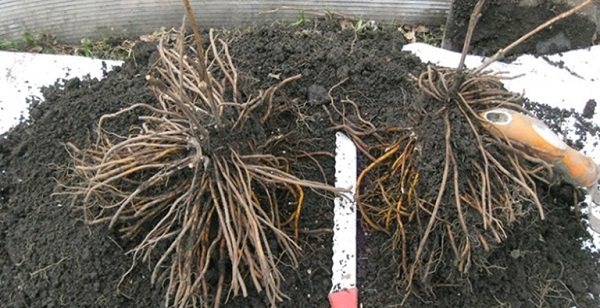

Layers
Bend the lower shoot to the ground, bury it in a previously prepared hole about 15 cm deep. Fix it with something so that it does not straighten. An incision can be made on the part of the shoot that will be in the ground. So it will take root faster. The cuttings need to be watered regularly. When roots appear on it, separate from the parent bush and plant separately.


Ash hydrangea
Ash hydrangea is an erect shrub with pubescent shoots up to 2 meters high. Leaves up to 15 cm long, round or cordate. The top of the leaf plate is bright green, the pubescent bottom is gray. Scutellum inflorescences reach 15 cm in diameter. Blooms from mid-summer to September.
The species is warm and moisture-loving. Not too picky about the composition of the soil. It has an average frost resistance, but even if it freezes, it quickly recovers in the spring and blooms on young shoots. It is recommended to cover for the winter.
Suitable for cultivation in the south of Russia... Looks spectacular as a hedge and in group plantings. The dried flowers are used for dry bouquets.
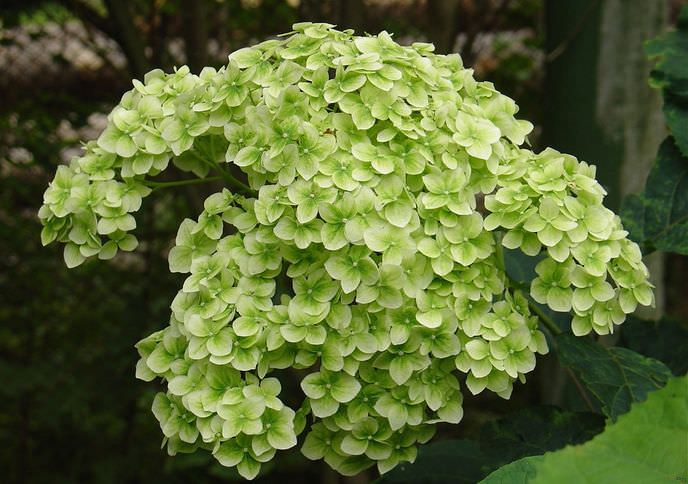

Protection from pests and diseases
Hydrangea has strong immunity and rarely gets sick. But sometimes, with improper care, it can become infected with chlorosis or powdery mildew. Chlorosis appears due to excess lime in the soil or humus. To get rid of the problem, it is necessary to water the plant with nitric acid potassium and copper sulfate every 3 days.
Powdery mildew occurs against the background of excess moisture. To cure a hydrangea, it is necessary to treat it with a solution of copper sulfate and regulate watering.
Of the pests, shrubs can attack:
- aphid;
- spider mite;
- stem nematode.
You can get rid of them with the help of insecticides (Fitoverm, Karbofos, Aktara). But if the plant is infected with a nematode, then it is better to dig it up and destroy it.
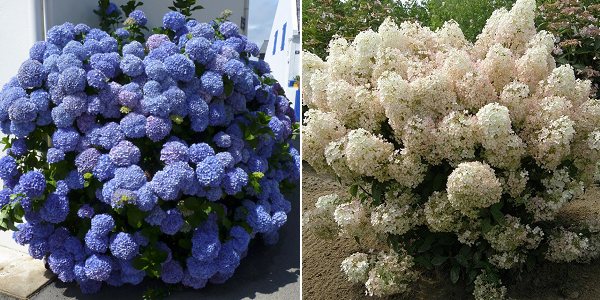

Serrate hydrangea
The serrated hydrangea is a tree-like shrub up to 1.5 meters high. Shoots pubescent or glabrous. Ovate pubescent leaves are green in color.
Globular inflorescences have white and blue flowers, small in the middle and larger at the edges.
The color varies depending on the acidity of the soil. Flowering lasts from July to September.
This species loves moderate watering.... Not too demanding in care, rarely affected by pests and diseases. Has an average resistance to frost. For the winter, it is better to cover with spruce branches or dry foliage.
Suitable for use as a herbarium. Recommended for growing in central and southern Russia.
Hydrangea care at home
Indoor hydrangeas are among the most difficult to care for. You cannot cope with them without experience, the bushes are unlikely to be preserved, and the flowering can be extended to six months. There are no unimportant points in caring for hydrangeas.
Watering and air humidity
The substrate in pots with indoor hydrangeas should never completely dry out - even during the winter. In accordance with the decrease in temperature, watering is reduced, maintaining very light soil moisture with small portions of water.
During the period of active growth, indoor hydrangeas require rather active watering, between which only 2-3 upper centimeters of the substrate would dry out. In this case, it is important to avoid dampness, but to maintain an average, uniform humidity.
In the spring, when hydrangeas build up their leaf mass, they consume an astonishing amount of water, so watering is usually done more abundantly while they are actively growing.
Water quality for indoor hydrangeas must be monitored. It should warm up to the same temperature as the air in the room. For these shrubs, only soft water is suitable. If in doubt about its quality, it is better to slightly acidify the water to prevent alkalization. Hydrangeas grow well when watered with melt water.
Hydrangeas do not tolerate heat and love medium humidity. If temperatures exceed a comfortable range, in order to maintain the beauty of the leaves in the crown, it is better to take care of humidifying the air and maintaining humidity indicators at least within 55-60%. Hydrangeas can be sprayed with a foggy method, they will not give up all types and artisanal moisturizers.
Top dressing and fertilizer composition
Indoor hydrangeas are fed only from March, when the duration of daylight hours begins to increase, and continue to be carried out not only until the end of flowering, but also until the end of October to lay high-quality buds. The classic frequency of 1 every 2 weeks requires a halving of the fertilizer dosage.
If you use the full dose, then it is better to apply fertilizing every 3-4 weeks. It is worth gradually starting feeding in early spring and finishing in mid-autumn.
All hydrangeas, without exception, prefer special fertilizers for rhododendrons. For indoor beauties, you should not experiment with the composition of fertilizers, because even preparations for flowering shrubs are not suitable for them. By reducing the dose, you can use a special fertilizer for garden hydrangeas. Organic fertilizers for indoor plants are not applied.
The luxurious blue colors in indoor hydrangeas can only be preserved in the same ways as in garden hydrangeas - by maintaining the correct acidity of the soil. Special fertilizers for blue hydrangeas, containing aluminum or simple alum, which are added instead of the usual dressing, will help to enhance the much desired heavenly colors.
They are used according to the manufacturer's instructions, strictly observing both the dosage and the frequency of these procedures. But it is worth remembering that blue colors can only be achieved with "colored" hydrangeas - purple or pink, and whites never change to blue.
Another trace element, to the lack of which indoor hydrangeas are very sensitive, is iron. When studying the composition of dressings, you should make sure that it is present in the list of elements.
Pruning and shaping hydrangeas
The rapid growth rates often come as a surprise to those who buy indoor hydrangeas without researching their features.These shrubs develop and grow at an astonishing rate, even on windowsills. But hydrangeas need pruning not for compactness, but for flowering - without it, these beauties will not bloom.
Pruning on room-sized hydrangeas should be done immediately after flowering. With late pruning, hydrangeas will bloom much poorer, or they may not bloom at all. Standard pruning is done at 1/3 of the branch height. If hydrangeas stretch out in spring, young twigs grow too quickly, they are re-pruned to contain and compact.
Sanitary cleaning on hydrangeas should be done regularly. Removing dry leaves, damaged parts, weak shoots, cutting off inflorescences as they wilt are needed not only to maintain a neat appearance, but also to maintain health and reduce the risk of damage to the bushes.
All indoor hydrangeas, as a rule, have much more stable shoots and do not fall apart under the weight of the inflorescences. But if there are signs of sagging of the branches and their poor stability, it is better to tie the bushes to the support.


Hydrangeas are one of the indoor plants that are extremely sensitive to the reaction of the soil and its quality.
Transplant, containers and substrate
Unlike many indoor plants, hydrangeas should not be transplanted in early spring when they start to grow. The best time to transplant these beauties is after flowering and pruning. If you postpone the transplant until February-March, during the most important period for the preparation of flowering, the hydrangea will have to face new conditions and move on to adapt, because of which it may not bloom at all.
But the requirement to transplant after the plant fills the old pot with roots is better for hydrangeas to break. They are transplanted annually, grown in sufficiently compact containers that allow them to develop throughout the year. Hydrangeas prefer wide and shallow pots.
Hydrangeas are one of the indoor plants that are extremely sensitive to the reaction of the soil and its quality. Even the slightest differences from the preferred pH values or unusual deviations in the new substrate are manifested primarily in the colors of the plant: hydrangeas bloom differently in different conditions.
To fully appreciate the characteristics of the variety and the color scheme of the plant, it is worth growing hydrangeas only in a special substrate for rhododendrons. This is especially true for hydrangeas with a cold palette of colors - blue, purple, blue-violet shades. Any hydrangeas feel uncomfortable in soil, the pH of which goes beyond 4-5.
Hydrangeas are handled very carefully, without contacting the roots and without destroying the earthen coma. After planting hydrangeas, abundant watering is carried out. It is better to keep the plant in high air humidity, very “mild” temperatures and light until growth resumes and adaptation is complete. Drainage at the bottom of the tank is required.
Indoor hydrangeas prefer mulching the substrate - both clean peat and decorative mulch (which does not obstruct air access to the roots) are suitable.
Hydrangea Sargent
Hydrangea Sargent is distinguished by large pubescent leaves up to 25 cm long. They are round or heart-shaped in shape. Shoots are thick and bristly. Inflorescences in this species are corymbose, consisting of pale purple fruiting flowers and white sterile, located at the edges.


Hydrangea Sargent needs a well-lit place and moist soil... In winter, all of its aboveground part freezes, but in spring the shoots grow to a height of up to 1 meter and bloom in July. For the winter, all shoots are cut off, and the root system is covered with spruce branches or fallen leaves.
Recommended for cultivation in the southern regions of Russia.
Description
Hydrangea is most often represented by branching shrubs up to 3 m in height.There are also large vines capable of growing up to 20 m and small trees with characteristic shrub features such as strong branching.
Most of the species are deciduous plants, but there are also evergreen representatives grown in the southern strip.
Hydrangea blooms in spring-autumn, releasing large rounded inflorescences - panicles, shields with two types of buds: small in the middle, large on the edge. A bright dome is formed, which, with proper care, remains until the end of September. Almost all species have snow-white petals, but pink, blue, red and purple are also found. Leaves are cordate, slightly elongated towards the end, pointed, saturated dark green color with prominent veins. The edges of the plate are serrated and the surface is rough. The fruit is a capsule containing many small black seeds.
What types and varieties are easiest to grow in the garden or in the country
The criteria for the ease of growing a certain type of hydrangea are its frost resistance, care preferences, requirements for soil, watering, and illumination.
The most suitable species for Russia are Panicle hydrangea and Treelike hydrangea. They are quite frost-resistant, rarely freeze slightly and are not too demanding to care for. Even with a minimal investment of time and effort, it is possible to grow lush and flowering bushes.
Large-leaved hydrangea is less cold-resistant, more demanding on the composition of the soil and watering... It is recommended rather for tub and pot cultivation.
Other types of hydrangeas also require a lot of attention and the creation of certain conditions for their successful growth.
Top dressing
Abundant watering quickly flushes nutrients from the soil. Therefore, for good development and abundant flowering, hydrangea needs regular feeding. Water for irrigation should be soft. Rainwater is best and can be collected on a barrel site. You can also water with settled tap water. From time to time, it is recommended to add a little citric acid or vinegar essence (about 1 teaspoon per 3 liters) to the water for irrigation - to prevent chlorosis of the leaves.
Hydrangea loves nitrogen fertilizers. They are necessary during the most active growing season - in the spring for the growth of shoots and abundant flowering.
In the second half of summer, the amount of nitrogen fertilizers is reduced or not applied at all to allow the shoots to mature and prepare for winter. The main emphasis is placed on phosphorus and potash fertilizers. At the end of summer, they are fed with organic fertilizer. But it is introduced without embedding it into the soil, since the root system of hydrangeas is located close to the surface and it is easy to damage it when digging. Organic fertilizers are given in liquid form (compost slurry, mullein infusion) or scattered under bushes before abundant watering. Rotted manure or compost is suitable for this. Wood ash should not be used as it will reduce the acidity of the soil.
Organic fertilizer can also be applied before flowering, this increases the inflorescences. The main thing is not to overdo it, so that fragile branches do not begin to break under their own weight. An approximate scheme for fertilizing a hydrangea (per 1 bush): in the spring: 20-25 g of urea, 30-35 g of sulfuric potassium, 30-40 g of superphosphate; during the budding period: 40-45 g of potassium sulfate, 60-80 g of super-phosphate, can be fed with slurry (3-5 liters of solution); at the end of summer: 15-20 kg of rotted compost or manure in the trunk circle of each bush.
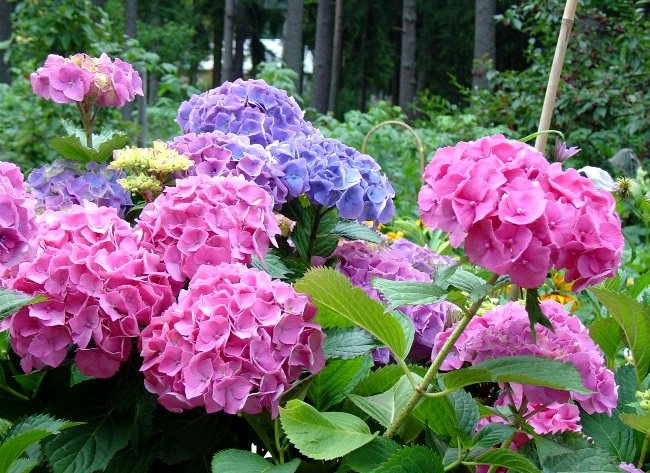

Infusion of mullein (another name - slurry) is prepared as follows. Mullein is mixed with water in a 1: 1 ratio, tightly closed and kept in a warm, dark place for 7-10 days. It is imperative to close it, otherwise nitrogen will escape from the fertilizer in the form of ammonia. The resulting mother liquor is diluted with water in a ratio of 1: 10 before use.
How to arrange hydrangeas with each other
For planting hydrangeas, a hole is dug, measuring 40x60 cm. Its depth varies from 35 to 70 cm, depending on the size of the seedling. To get a free hedge, you need to dig up a meter strip.
The distance between adult specimens should be 1.5-2.5 meters... To get a flower "bouquet" early, the pits are marked every 0.7-1 meter, and after a few years the group is thinned out.
Knowing about the features of each species and variety, you can choose the most optimal option for your garden. And then the luxurious hydrangea will surprise you with the splendor of the foliage and the bright riot of caps-inflorescences!
In the article, you learned what types and varieties of hydrangeas are suitable for growing in Russian gardens. You can find out about caring for hydrangeas in the garden here.

